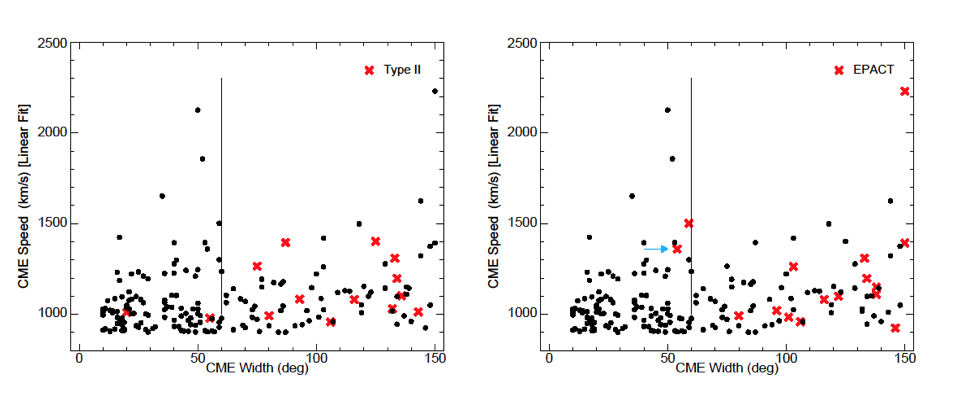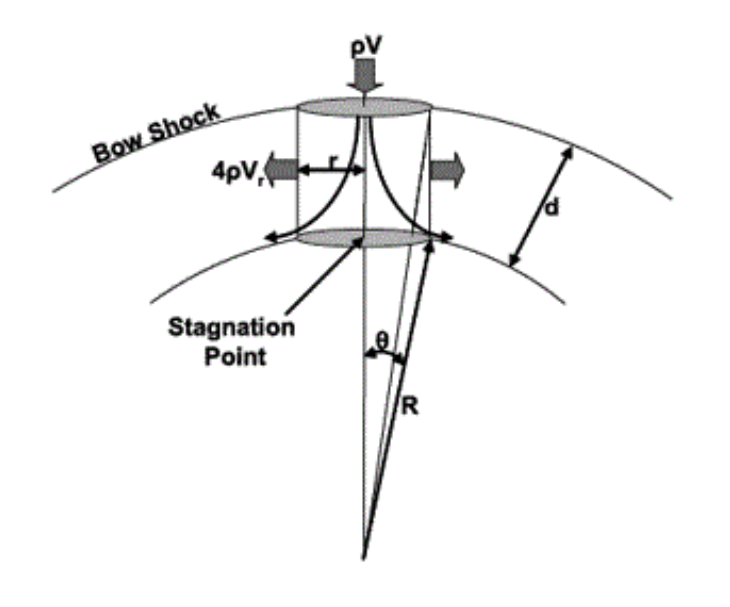Gradual solar energetic (E > 10 MeV) particle (SEP) events, lasting several days, are produced in coronal/interplanetary shocks driven by fast (VCME ≥ 900 kms−1) coronal mass ejections (CMEs) associated with type II radio bursts. The basic paradigm is that CMEs with VCME > Vf, the plasma fast-mode speed, drive shocks that can accelerate seed particles to the high energies observed as SEP events in space as well as electrons producing metric and decametric type II radio bursts. Coronal models of Vf, or of Va, the Alfvén speed, generally show Vf < 500 kms−1 above 10 R$_{\odot}$, favorable for shock production by fast CMEs.
Early surveys of fast CMEs associated with decametric-hectometric (DH) type II bursts (Gopalswamy et al., 2008) and with 20-MeV proton SEP events (Kahler & Reames, 2003) found good associations with fast and wide (FW, W > 60⁰) CMEs, but hardly any for fast and narrow (FN, W < 60⁰) CMEs (Figure 1). Variations in coronal Va could explain some FW CMEs without these associations or slower (VCME ~ 400 kms-1) CMEs with them, but why the FN CMEs were excluded was not obvious. We first confirm these results with an updated and larger CME data set.

Figure 1 – Left and center: Association rates of DH type II bursts as functions of CME speeds and widths (Gopalswamy et al., 2008). Right: Plot of log 20-MeV peak intensities versus CME W for 75 fast CMEs from the west limb (Kahler & Reames, 2003). Points with no SEP events are plotted at log intensity of -3.5. Points at 360⁰ are halo CMEs.
Data Analysis
We selected from the LASCO CME catalog (https://cdaw.gsfc.nasa.gov/CME_list) 232 fast CMEs with 10⁰ < W < 150⁰ and position angles at the west limb to compare with comprehensive lists of metric type II bursts and of SEP events at two energies. Figure 2 shows the metric type II burst and Wind/EPACT 20-MeV SEP event associations, with the FN CMEs to the left of the vertical lines. In each case there are only two events in the FN range, confirming a general absence of FN associations with both type II bursts and SEP events.
What is Different about the FN CMEs and their Shocks?
CME-driven shocks can be described by two fundamentally different processes. The first is the familiar bow shock, formed as solar wind (SW) flows around a relatively narrow projectile, and the second is an expansion shock, formed ahead of a piston driver expanding outward and accreting SW.
 Figure 2 – Associations of FN CMEs (left of vertical lines) with type II radio bursts (left) and 20-MeV SEP events (right). The blue arrow in right panel points to an impulsive, not gradual, SEP event.
Figure 2 – Associations of FN CMEs (left of vertical lines) with type II radio bursts (left) and 20-MeV SEP events (right). The blue arrow in right panel points to an impulsive, not gradual, SEP event.
Insightful model comparisons of the two kinds of shock sheaths were carried out by Siscoe & Odstrcil (2008). One difference is that the calculated shock stand-off distance is smaller for the expansion shock than for the bow shock when normalized to the same driver radius of curvature. An important factor is that the CME is expanding within an outflowing SW, so that the azimuthal expansion speed is always greater than the radial speed of the CME front relative to the SW flow. The sheath thickness of the piston-driven shock is then too small to allow the accreting SW material to flow around the flanks. If the sheath thickness is not comparable to or larger than the lateral extent of the CME, the model breaks down because plasma escapes around the sides of the CME, as shown in Figure 3. White-light structures observed ahead of CMEs have been confirmed by various authors to be driven fast-mode shocks, but the choice between a piston-driven or bow shock interpretation has not been clear. Our observational results suggest, however, that FN CMEs are mostly bow shocks and FW CMEs predominately expansion shocks.
FN CMEs seem likely to form bow shocks, but can those bow shocks also produce SEP events, as do the FW CME shocks? The obvious FN CME counterpart is the Earth’s bow shock, a stationary reverse shock with a density jump of a factor of four, larger than CME forward shock jumps. Particles travelling upstream along magnetic fields from electron and ion foreshock regions of Earth’s strong bow shock reveal only steep energy spectra in the 30 to 300 keV nuc−1 energy range and ≤ 1MeV nuc−1, in contrast to up to GeV energies in FW CME-driven shocks. If FN CMEs also generate bow shocks in the SW, then production of E > 10 MeV SEP events would also seem unlikely. A possible limiting factor is the particle acceleration time scale τ = L/Vsz, where L is the shock accelerator region size and Vsz is the convection speed with which the magnetic flux bundles move across the shock accelerator. This term should be minimal for FN CMEs, with both small L and fast Vsz combining to limit the acceleration time τ.
 Figure 3 – The bow shock (Siscoe & Odstrcil 2008), in which the inflowing material is compressed and deflected to flow through the sheath around the driver. In the expansion shock the sheath is too narrow to allow SW flow around the CME and the SW accretes behind the shock.
Figure 3 – The bow shock (Siscoe & Odstrcil 2008), in which the inflowing material is compressed and deflected to flow through the sheath around the driver. In the expansion shock the sheath is too narrow to allow SW flow around the CME and the SW accretes behind the shock.
Conclusions
The general lack of FN CME associations with type II radio bursts or SEP events is confirmed with a sample of 232 west limb CMEs. We explain this result in terms of a fundamental difference between the bow shocks of FN CMEs and the piston-driven shocks of FW CMEs. Distinguishing between the two models for an observed CME can be ambiguous, and it is not clear why W = 60⁰ seems to provide a limiting factor between the FN and FW CME types.
Based on a recently published paper: S. W. Kahler, A. G. Ling, & N. Gopalswamy, Solar Phys., 2019, 294:134
References
Gopalswamy, N., Yashiro, S., Xie, H., et al.: 2008, Astrophys. J., 674, 560
Kahler, S. W., & Reames, D. V.: 2003, Astrophys. J., 584, 1063
Siscoe, G., & Odstrcil, D.: 2008, JGRA, 113, A00B07
